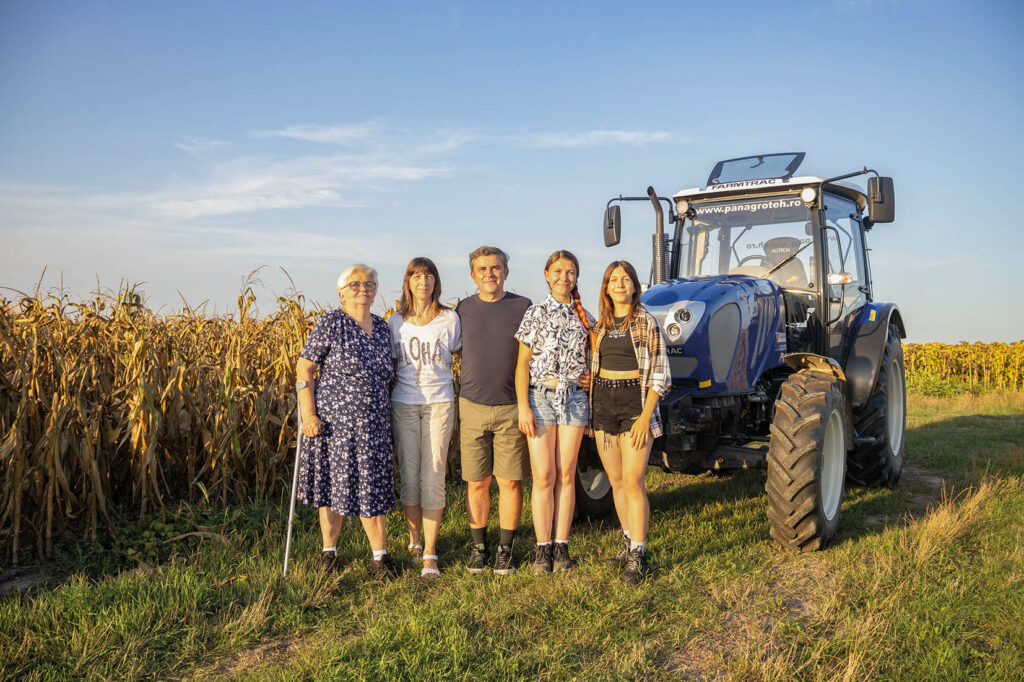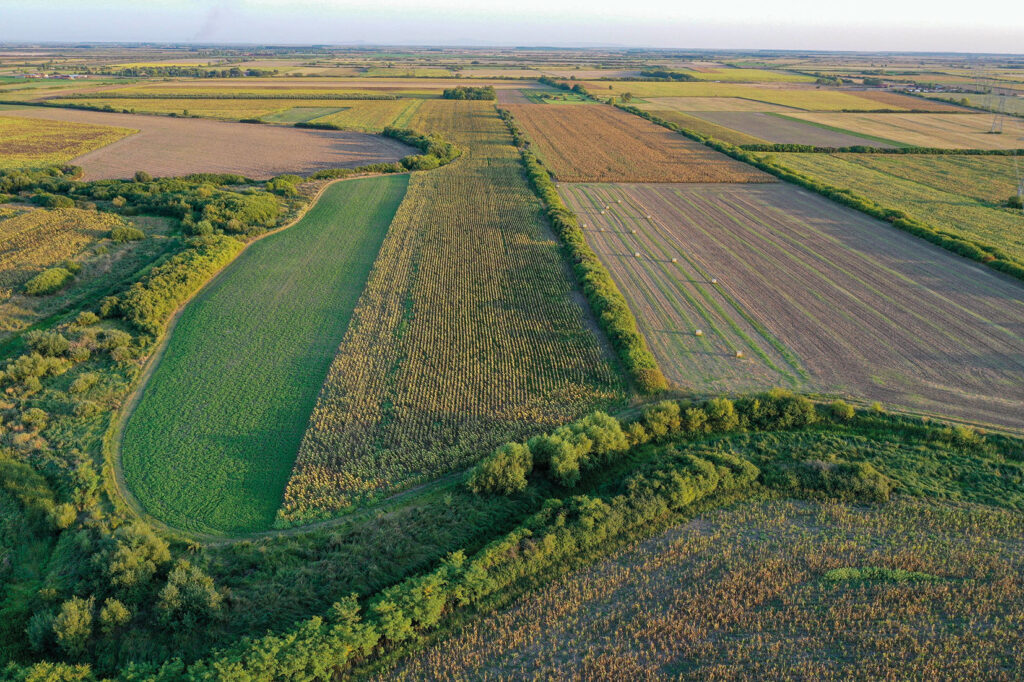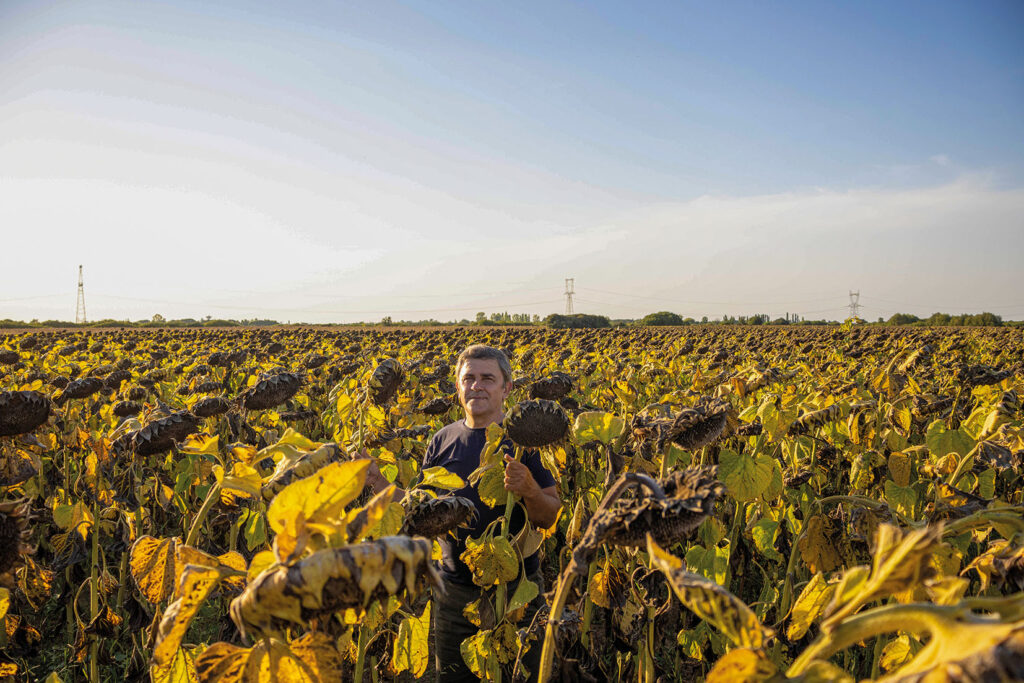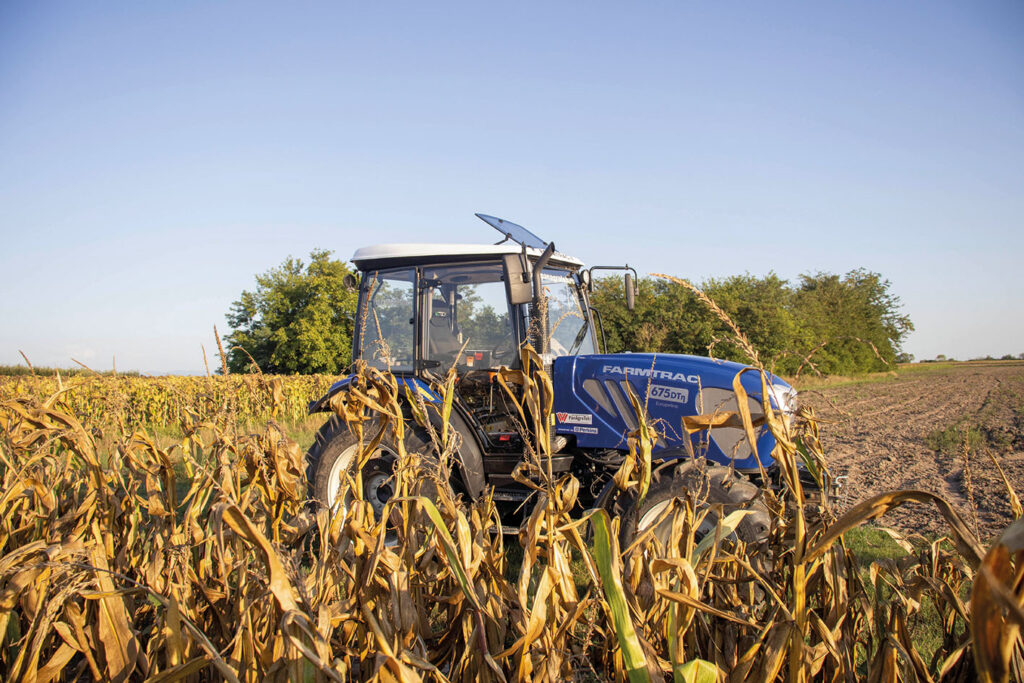Battling the effects of war, drought and extreme weather events: A Romanian farmer’s perspective
26th September 2022
Farmers Guide staff writer, Henrietta Szathmary, returned to Romania recently to visit her family farm, run by her father Laszlo. She discusses the effects of the Russian conflict, adding to existing challenges amid increasingly extreme weather.

The Szathmary family on their farm in Romania. Farmers Guide staff writer Henrietta Szathmary is pictured fourth from left with (l-r) her paternal grandmother Ilona; mother, Anita; father Laszlo and sister, Victoria.
Over the past decade, my father, Laszlo, and our family have encountered our fair share of challenges managing 60ha of arable land in Bihor County, Romania. As a sixth-generation farmer, however, Laszlo is determined to maintain the family legacy started by our ancestors in the 19th century.
The Szathmary family initially started farming on 12ha of land, which made them mid-level farmers for the region at that time. Laszlo still recalls his grandfather, my great-grandfather, experimenting with a wide range of crops, including barley, oats, sugar beet, wheat, maize, sunflowers, and lucerne. Our family also raised cattle, swine and poultry back in the day, selling their produce in local markets.
Unlike British agriculture, Romanian farming experienced a major setback with the arrival of communism in 1945. In the years that followed, taxes on agricultural produce were raised to unreasonable heights, forcing many farmers to join collective farming units.
Due to repeated refusal to give up their assets, our family lost all of their land, animals, and machinery in the 1950s. It wasn’t until two years after the fall of communism in 1989 that our family regained a portion of our former lands and started farming again.
The family business was picked up by my paternal grandfather – a former electrician who dedicated the rest of his life to farming and continuing the family legacy. He purchased machinery and began growing wheat and maize alongside raising swine and laying hens.
After his sad passing in 2003, Laszlo took over the family farm and has been working it part-time for the last 20 years. Keeping only a small number of laying hens, he upgraded existing machinery and focused primarily on crop production.
Over the years, Laszlo increased the family holdings to 60ha by purchasing land from our relatives. He currently farms winter wheat, maize and sunflowers on mainly clay and sand loam soils at the 30ha Kocsordos Farm, and rents the remaining parcels out to local farmers.
For Laszlo, farming is a major commitment next to his full-time job in IT, which is why he only farms half of the family land. With only my uncle and my mother helping occasionally, he carries out most of the farm work throughout the year himself.
As for his day job, Laszlo has so far refrained from cutting the cord and going all-in with farming. With climate change bringing about unpredictable crop yields, trading the security of employment for volatile profits is a risk he can’t afford to take.
“It is good like this,” he says. “After the stress of office work, I can go and unwind in nature.”

Sixth-generation farmer Laszlo Szathmary grows a variety of crops including winter wheat, lucerne, maize and sunflowers at Kocsordos Farm, as well as renting out parcels of his land to neighbouring farms.
Hot and dry summers are an ongoing hindrance
With this year being the hottest and driest in half a century, British growers have faced unprecedented challenges in arable farming. However, in countries like Romania, prolonged periods of drought and extreme heat have been weighing down the agricultural sector for the past decade.
Like other arable farmers, Laszlo has adjusted his cultivation practices to suit the local climate. Since most of the rainfall occurs in the autumn and winter, he grows winter wheat to take advantage of abundant moisture.
The wheat varieties grown at Kocsordos Farm are Genius, Apache, and Glosa (local Romanian) varieties with good milling properties. Upon harvest, Laszlo sells most of the wheat to the local flour mill, taking only a small amount home to use as seed the next year.
Despite the extreme drought conditions of the past two years, wheat yields have remained relatively high at our family farm. However, the same cannot be said about maize and sunflower yields, which have suffered heavy losses over the summer months. Irritatingly for farmers, plentiful rainfall often occurs in late August, when it does crops more harm than good.
The majority of maize from our farm is sold directly to a trading company for export, with Laszlo transporting a small amount home for local customers. Whereas, the entire sunflower yield goes directly to an oil factory to be used for human consumption and animal feed production.
Despite both maize and sunflower being of the drought-tolerant Pioneer varieties, the crops struggled to produce yield in this year’s harsh conditions. With temperatures consistently over 35°C this summer, the heat severely compromised crop viability alongside little-to-no rainfall.
With the lack of a profitable yield, many farmers opted to cut maize stalks prematurely for silage.
During an average year, Laszlo normally drills equal amounts of wheat, maize, and sunflowers. However, given the current conditions, he is considering growing more wheat and possibly sorghum to achieve higher and more consistent yields.
To make matters bleaker, irrigation isn’t a feasible option for our family farm. As much as we would like to use water to counter the drought, irrigation would only be possible via drawing a well, which is neither practical nor cost-effective at present.

Alongside farming, Laszlo has a full-time job in IT; with climate change bringing about unpredictable crop yields, he cannot afford to trade in secure employment for volatile profits.
Farming practices at the family farm
The typical crop rotation at Kocsordos Farm is wheat / maize / sunflowers. Wheat fields are disc-cultivated in the autumn, followed by drilling in October and fertiliser application in the spring. To keep weeds at bay, the crops receive a post-em herbicide treatment (tribenuron-metil) in early April.
Fields meant for maize and sunflowers are deep-ploughed in the autumn (to 30–35cm), then levelled in the spring with a combinator. Laszlo then adds complex, slow-degrading fertiliser to the soil and levels the fields once more before drilling.
With maize, he adds fast-degrading nitrogen fertiliser to the seedbed when drilling. Two to three days later, the seedbed receives a herbicide treatment, which is repeated when the crops have reached V6–V8 stages.
The cultivation process is fairly similar for sunflowers. For drilling, he uses Pioneer hybrid seeds which feature an ExpressSun herbicide-tolerant trait. This type of seed has only been available for the last 10 years and has been selectively bred for herbicide resistance.
Other than the combine harvester, Laszlo owns all of the machinery used on our family farm. This includes a smaller 45hp and a larger 75hp tractor (FarmTrac 675 DTŋ), two ploughs, two disc harrows, a combinator, a fertiliser spreader, a sprayer, a wheat and a maize/sunflower seed drill, a roller, a maize stalk shredder, and three large trailers. When expanding his inventory, he always buys new machinery from local suppliers.
During harvest, Laszlo hires a combine harvester and operator, who is the only seasonal worker on the farm. Besides harvesting crops, he also helps with transporting grain to buyers when yields are high.
Regarding control systems, Laszlo uses a range of biocides to protect crops from weeds, insects and harmful fungi. Against fungal diseases, all crops receive fungicide seed treatment and wheat fields are sprayed in May. Common diseases threatening crops in the area include powdery mildew, downy mildew, fusarium head blight, and septoria.
To combat weeds and insects, wheat is sprayed with herbicides in April and insecticides at the end of May. Maize and sunflower are treated again with herbicides when they reach a height of 0.5m to counter renewed weed growth.
The key problem weeds for each crop are:
- Wheat: Common windgrass (Apera spica-venti), creeping thistle (Cirsium arvense), cleavers (galium aparine)
- Maize: Field bindweed (Convulvulus arvensis), Johnson grass (Sorghum halepense), green foxtail (Setaria glauca), common cocklebur (Xanthium strumarium)
- Sunflowers: Creeping thistle (Cirsium arvense), common cocklebur.
Pests like deer, crows, pheasants, hares and small rodents can also cause considerable damage to crop fields. In Romania, deer are by far the most destructive of all pests and are abundant in number across the country. Unfortunately for growers, they are a protected species by law and hence cannot be controlled efficiently.
Like many others in the area, our family farm lacks an integrated pest control system. Insecticides and good old-fashioned scarecrows are as far as most farmers go regarding pest control.
The impact of the Ukrainian war on Romanian agriculture
Alongside rising temperatures and reduced rainfall, Romanian growers have suffered further losses due to the outbreak of war in neighbouring Ukraine on 24th February, 2022. In addition to the same effects felt throughout Western Europe in terms of fertiliser, fuel and energy cost, Romanian farmers must also tackle a drop in wheat prices, as cheap Ukrainian grain floods the market.
With ongoing fighting cutting off Ukraine’s export routes towards the east and the sea, Romania has become a major destination for Ukrainian grain. Due to prices being significantly lower in the war-stricken country, Romanian traders have been importing considerable amounts of Ukrainian wheat, leading to a fall in demand for Romanian wheat.
Unfortunately, there is little that Romanian farmers can do to counter plummeting wheat prices. Reducing inputs such as fertiliser and biocide use might adversely affect crop yields and is therefore not a viable option. Instead, many farmers are choosing to hold onto their wheat in hope of better prices a few months down the line.
Laszlo also stores some of the wheat and maize at our family home while waiting for prices to rise. However, like many other small farmers, he has limited storage capacity and is therefore at a disadvantage.
Fertiliser cost is currently 4–5 times what it used to be due to rising gas prices. The cost of machinery parts has also notably increased as metal prices doubled following the bombardment of Azovstal Steel Plant in Mariupol. Combined with already high fuel and energy prices, these factors will have a significant impact on Romanian crop production this year.
Looking into the future
Although Romania is one of the EU’s largest wheat, maize, and sunflower exporters, it used to be much more agri-oriented than it is today. Nowadays, jobseekers turn towards opportunities in the industrial and service sectors rather than a career in agriculture.
According to Laszlo, farming is not attractive to younger generations, which creates further uncertainty regarding the future of farming. Most farmers are in their mid-40s and 50s, facing the prospect of having to sell or lease out their lands when they retire. These farms are often absorbed into larger operations, continually reducing the number of small farmers in the country.
As the sole operator of our family farm, Laszlo is facing a similar future. Myself, my sister and our relatives have all made other commitments and will not be carrying on the family legacy. However, until the time comes to throw in the towel, he will continue to savour all that farming has to offer.

